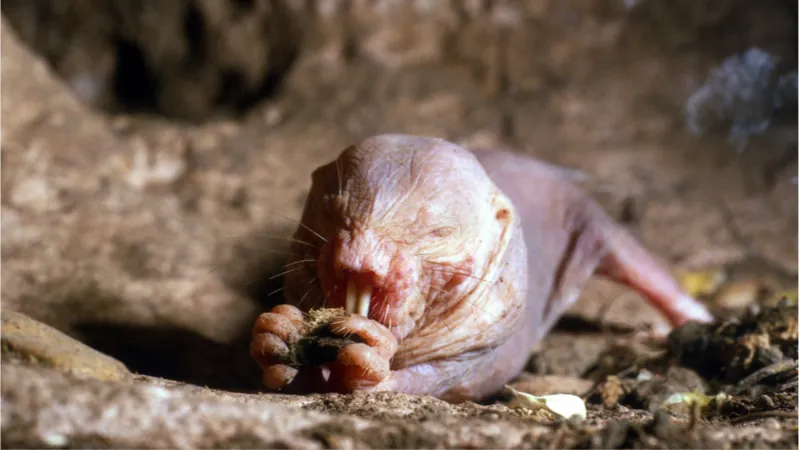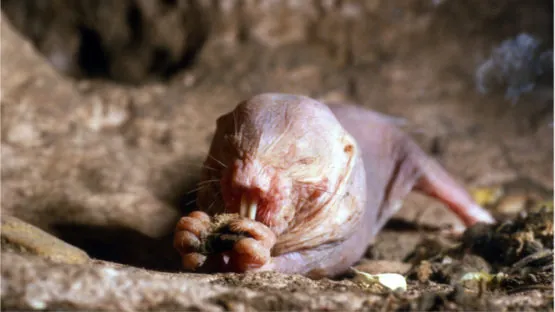The well-known resistance of naked mole rats to aging and aging-related effects is due at least in part to an unusual ability to clear away senescent cells. This suggests that senolytic drugs, which aim to do the same in humans, may prove a fruitful path to longevity.
Naked mole rats live much longer than other rodents
Naked mole rats are highly social African mammals that live in underground tunnels. These animals are famous among biologists for their extraordinary longevity – living as long as 32 years – as well as their resistance to a range of age-related disorders, including neurodegenerative diseases and cancer. Unlike humans, their mortality rate doesn’t increase with age, meaning that an elderly naked mole rat is no more likely die of “natural causes” than its younger counterparts.
If we could understand how naked mole rats stave off the effects of aging, that could help researchers figure out how to do the same thing in humans. Even if we can’t directly apply whatever tricks the naked mole rats use to keep the Grim Reaper at bay, we might get some hints about which research avenues would be best to pursue.
A lack of senescent cells
One of the open questions about naked mole rats was the fate of their senescent cells, which are cells that have stopped dividing in response to DNA damage or other stress. They secrete inflammatory cytokines and a collection of other molecules, contributing to inflammation, immune imbalance, and other age-related physiological changes. In general, senescent cells accumulate with age, but it was unclear whether this is true in naked mole rats.
A research team based in Japan addressed this question in a paper published on bioRxiv [1], a preprint archive where papers are available before they have been peer reviewed. The team measured the number of senescent cells in skin samples from young and middle-aged mice and naked mole rats. In contrast to the mice, where senescent cells increased with age, they found nearly no senescent cells in the middle-aged mole rats. The teams found the same results when they induced cellular senescence by irradiating samples with UV; senescent cells accumulated in the mouse samples but not in naked mole rat skin.
Strength through vulnerability
A crucial clue was found in the observation that there were lots of floating, dead cells in naked mole rat cell cultures that had been treated to induce senescence. By tracking when the cells died and correlating it with gene expression, the team showed that it was linked with senescence. They also tested other ways of inducing senescence to confirm that this wasn’t a response to a specific inducer.
The team dubbed this phenomenon “senescent cell death”. Further analysis revealed that genes related to the autophagy-lysosome degradation system were misregulated in the senescent cells. The cells also had stronger expression of genes related to oxidative stress, suggesting that an increase in reactive oxygen species might be causing senescent naked mole rat cells to die.
Reactive oxygen species damage macromolecules inside cells, and they are known to increase in senescent cells. However, in human and mouse senescent cells, this increase doesn’t lead to cell death. Naked mole rat cells are unusually vulnerable to reactive oxygen species, but this apparent weakness may in fact be a key to longevity.
When the researchers compared senescent cells from naked mole rats and mice, they found a striking difference in their metabolic profiles. Senescence caused a large shift in the metabolic profile of mouse cells, but the change was much smaller in the naked mole rat cells. This may explain why naked mole rat cells are less able to deal with an increase in reactive oxygen – they don’t adjust their metabolism to compensate. In fact, the team found that two pathways which produce reactive oxygen species were more active in senescent mole rat cells.
Naked mole rats may have developed a poor defense against reactive oxygen species because oxygen levels are low in their underground burrows. This makes their senescent cells especially vulnerable to reactive oxygen species, but that turns out to be useful since it clears senescent cells from their systems, helping them avoid many of the harmful effects of these cells.
Naked mole-rats (NMRs) are the longest-lived rodents, showing minimal aging phenotypes. An unsolved paradox is that NMRs exhibit low intracellular anti-oxidant defence despite minimal aging. Here, we explained a link between these “contradicting” features by a phenomenon termed “senescent cell death (SCD)”—Senescence induced cell death in NMR cells due to their inherent vulnerability to reactive oxygen species and unique metabolic system. In NMR skin, we observed few senescent cells during aging or after ultraviolet irradiation, suggesting suppression of senescent cell accumulation in NMR tissue. We discovered that senescent NMR-fibroblasts induce SCD through retinoblastoma protein activation accompanied by autophagy dysregulation, increased oxidative damage and accelerated H2O2-releasing metabolic pathways. During senescence, NMR cells showed resistance to metabolic remodelling unlike mice. Our findings provide mechanistic insights into how extraordinary aging resistance is accomplished in NMR. This will contribute to the development of senolytic drugs to regulate age-related diseases.
Conclusion
Using senolytic drugs to kill senescent cells is one of the approaches under investigation to increase human lifespan and healthspan. The discovery of senescent cell death in naked mole rats, known for their exceptional longevity, strengthens the case for this approach in humans.
Literature
- Kawamura, Y., Oka, K., Takamori, M., Sugiura, Y., Oiwa, Y., Fujioka, S., … Miura, K. (2020) Senescent cell death as an aging resistance mechanism in naked mole-rat. bioRxiv, doi:10.1101/2020.07.02.155903




